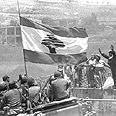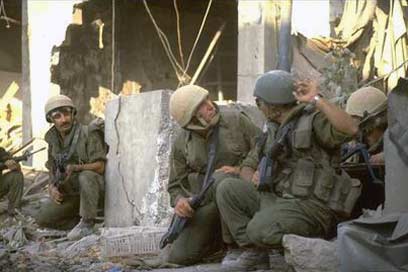
War's prelim
In 1978 Israel launched Operation Litani, temporarily occupying southern Lebanon up to the Litani River. Once the IDF withdrew its forces later that year, an alliance was formed between the IDF and the South Lebanon Army (SLA), resulting in a buffer zone along Israel’s border.
The IDF's control over several outposts within the buffer zone did not, however, discourage the PLO, as its operatives managed to slip back into the region, southeast Lebanon and the slopes of Mount Hermon. The buffer zone was expanded and relabeled the “security zone,” but the armed Palestinian groups continued to launch numerous attacks from the area.
While battling the Palestinians in southern Lebanon and trying to strengthen the SLA, Israel held covert talks with Christian leaders in Lebanon, who were concerned that an independent Palestinian presence in their country would further deteriorate their already shaky stance within national politics. The understandings reached in these talks, although never made public, went to on play a pivotal part in the events, as they unfolded.

IDF tanks on the Lebanese border, June 1982 (Photo: GPO)
In July 1981 the US negotiated a ceasefire between Israel and the PLO. The ceasefire was violated one year later, on June 3, 1982, when a gunman affiliated with the Ahmed Jibril movement tried to assassinate Shlomo Argov, the Israeli ambassador to London. Argov suffered a serious – but luckily not fatal – head injury. Then-Prime Minister Menachem Begin called a special cabinet meeting following the attempt on Argov's life. The meeting ended with the cabinet voting in favor of striking targets in Beirut and southern Lebanon. The PLO responded with massive shelling on Israel’s northern communities, with Kiryat Shmona taking most of the fire.
War breaks out
IDF forces marched into Lebanon on June 6, 1982 as the government announced that Israel’s objective was to push the armed groups northward, thus ensuring the northern Israeli communities were safely out of fire range. The operation was meant to be no more than 48 hours long, reaching 25 miles into Lebanon. IDF forces, however, ended up reaching the outskirts of Beirut.
As Israeli forces pressed northward, Syrian forces launched an offensive in eastern Lebanon. A clash proved unavoidable as Damascus sent reinforcements to the Bekaa Valley and launched an attack against IDF troops; but the Israel Air Force destroyed most of Syria’s missiles batteries in Lebanon, shooting down 27 Syrian fighter jets in the process. Syria ended up losing about 100 jets in the fighting.
By June 14, IDF forces were surrounding Beirut. Joined by Christian Phalanges in the eastern sector of the city, the plan was to impose a “new order” in Lebanon: Israel was to help Lebanon become free of Syrian and Palestinian influences, thus securing peace for both sides.
Seizing Beirut was meant to force the Syrian and PLO forces out of the city. The blockade lasted from July through mid-August, when PLO forces, and Yasser Arafat among them, began leaving the city under the protection of a multinational force on August 25 and was completed five days later.

IDF forces leaving Sidon (Photo: GPO)
Christian forces leader Bashir Gemayel was soon elected president of Lebanon, but just several weeks later he was assassinated in Beirut. Shortly after the news of the assassination broke, IDF forces entered western Beirut. The Israeli cabinet was later said to have heard about the incursion on the radio.
Sabra and Shatila
The IDF and the Christian Phalanges had agreed that the latter would deal with any remaining terrorists in the western sector of Beirut. It was also decided that they would comb through the refugee camps, arrest any remaining terrorists and hand them over to the IDF. The Phalangists who entered the Sabra and Shatila refugee camps in September 1982, however, sought revenge for the murder of their leader and massacred some 800 Palestinian civilians.
The IDF reportedly had intelligence warning of potential retribution by the Phalangists, but did nothing to prevent the acts. News of the massacre resulted in a local and international uproar and then-Prime Minister Begin came under intense pressure to form an official committee of inquiry into the matter. Begin eventually did just that, forming the Kahan Committee in September of 1982.
The subsequent Kahan Report stated the following:
- Ariel Sharon was
unfit to serve as the defense minister. The committee urged Sharon to acknowledge his failures. Sharon was forced to resign.
- IDF Chief of Staff Lieutenant-General Rafael Eitan was found negligent, but since his term in office was nearing its end, the committee did not recommend his dismissal.
Following the massacre, the IDF left western Beirut and a multinational force took its place. The US special envoy to the region, Philip Habib, brokered the withdrawal of all foreign armies from Lebanon – Israel, Syria and the PLO, as well as ceasefire between Israel and Lebanon; but the Lebanese recanted the deal due to Syrian pressure. IDF forces began a graduate withdrawal to the south, suffering mass casualties in the process.
The 18-year withdrawal
On November 4, 1983 the IDF headquarters in Sidon was attacked and 36 soldiers were killed. The multinational force was targeted numerous times as well: On October of 1983 the US and French forces lost 241 and 58 soldiers respectively, and as a result the multinational force essentially ceased to exist. Meanwhile, the Lebanese government inability to enforce its authority resulted in dozens of armed militias roaming free in southern Lebanon; and in continued clashes between the militias and IDF forces.
The mass casualties suffered by the IDF led to the Israeli public being heavily divided about the necessity of the war in Lebanon, which was perceived by many as "elective fighting." The escapade, which was dubbed "the Lebanese mess"," eventually led to Begin's decision to resign as PM in August of 1983.

In the field, June 1982 (Photo: GPO)
January of 1985 saw the Israeli government decide to gradually withdraw from Lebanon, and by springtime most of the IDF's troops – with the exception of those stationed in the south Lebanese buffer zone – were out of Lebanon.
According to the Defense Ministry, Israel suffered 1217 fatalities in the war itself, which lasted between 1982 and 1985.
Over the course of the next 15 years the IDF would launch two large-scale operations in Lebanon – Operation Accountability and Operation Grapes of Wrath – both in an attempt to prevent Hizbullah’s continued attacks on northern Israel. The rising number of fatalities among IDF soldier stationed in the buffer zone led to a growing public outcry to pull all troops out of the area and in 1999, then-Prime Minister Ehud Barak led his government to vote for the complete withdrawal from Lebanon.
The last Israeli soldiers left Lebanon on May 24, 2000.














